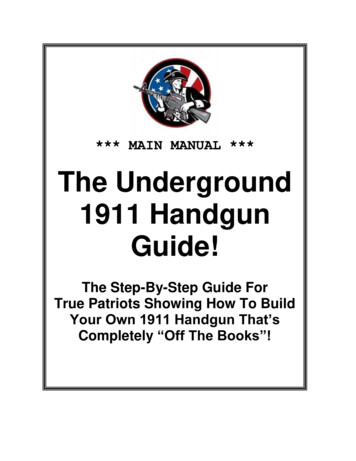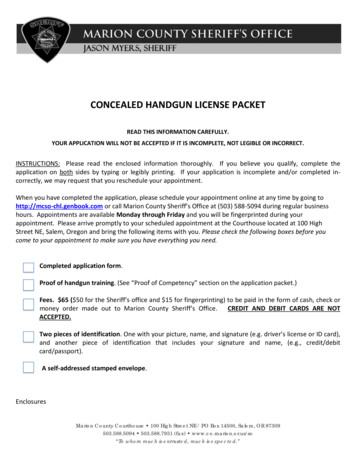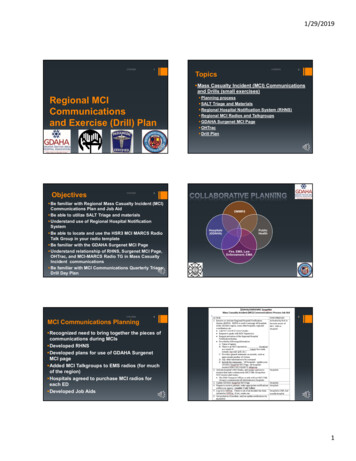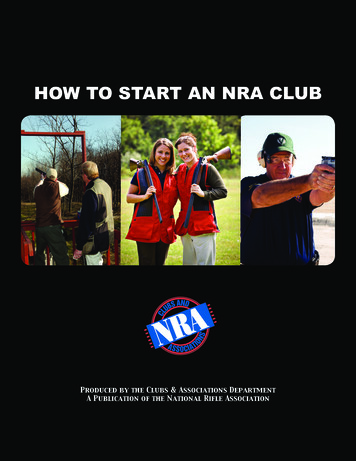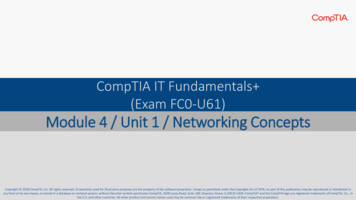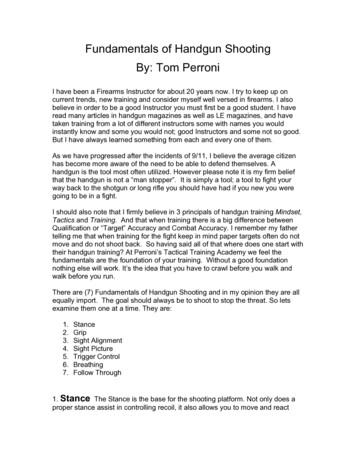
Transcription
Fundamentals of Handgun ShootingBy: Tom PerroniI have been a Firearms Instructor for about 20 years now. I try to keep up oncurrent trends, new training and consider myself well versed in firearms. I alsobelieve in order to be a good Instructor you must first be a good student. I haveread many articles in handgun magazines as well as LE magazines, and havetaken training from a lot of different instructors some with names you wouldinstantly know and some you would not; good Instructors and some not so good.But I have always learned something from each and every one of them.As we have progressed after the incidents of 9/11, I believe the average citizenhas become more aware of the need to be able to defend themselves. Ahandgun is the tool most often utilized. However please note it is my firm beliefthat the handgun is not a “man stopper”. It is simply a tool; a tool to fight yourway back to the shotgun or long rifle you should have had if you new you weregoing to be in a fight.I should also note that I firmly believe in 3 principals of handgun training Mindset,Tactics and Training. And that when training there is a big difference betweenQualification or “Target” Accuracy and Combat Accuracy. I remember my fathertelling me that when training for the fight keep in mind paper targets often do notmove and do not shoot back. So having said all of that where does one start withtheir handgun training? At Perroni’s Tactical Training Academy we feel thefundamentals are the foundation of your training. Without a good foundationnothing else will work. It’s the idea that you have to crawl before you walk andwalk before you run.There are (7) Fundamentals of Handgun Shooting and in my opinion they are allequally import. The goal should always be to shoot to stop the threat. So letsexamine them one at a time. They are:1.2.3.4.5.6.7.StanceGripSight AlignmentSight PictureTrigger ControlBreathingFollow Through1. Stance The Stance is the base for the shooting platform. Not only does aproper stance assist in controlling recoil, it also allows you to move and react
quickly and to draw your weapon with minimal movement. The proper stanceconsists of:a. Shoulders square to the target.b. Feet shoulder width apart.c. Weight slightly forward on the balls of the feet.d. Head remains high and still with chin pointing at the target.e. Ears in front of shoulders, shoulders in front of hips.f. Be Comfortable.Types of Stances:WeaverIsoscelesModified WeaverModified IsoscelesDynamicThe shooting stance is basically a support or shooting platform. The quality of thestance is a major determining factor in creating conditions for maximum controland accuracy for shooting. A high degree of control is necessary to deliver arapid, accurate shot. Every individual is unique and possess characteristics thatare their’s alone. These characteristics include height, weight, muscular andskeletal development, degree of flexibility and more. Therefore, there can be nouniversal shooting stance that can be utilized by all people.Each shooter, under the guidance of the FirearmsInstructor, and consistent with safety must find theshooting stance which is best suited to them andprovides the greatest degree of stability andaccuracy for shooting. The shooter must be ableto assume their stance instinctively, as a reflexaction with minimal effort or consciousmanipulation of their body.2. Grip A proper grip aids in controlling recoil and muzzle flip. It also allowsthe shooter to obtain a second sight picture more rapidly. Hands must have a360 degree grip around the weapon. This allows the shooter to engage morerapidly.
Ideally, the weapon should be placed in the hand so a straight line is formed withthe barrel of the weapon and the forearm. The webbing of the hand should befully under the tang of the back-strap. The weapon must initially be gripped withsufficient force to cause shaking and gradually released until the shaking stops.The support hand applies pressure in exactly the same fashion. The idea behindthe two hand grip is to completely encircle the grip of the gun in order to be incontrol of recoil. The support hand thumb will be on the same side of the gun asthe weapon hand thumb. The Grip must be consistent for each shota good grip enhances accuracyhigh on the back strapfinger must reach the triggerwill reduce muzzle riselends to faster recoil recoveryjust as firm as a handshake, no firmerweak side fingers should be wrapped around the strong handwrists should be close togethersupporting hand heel should be in contact with the weapon gripThumbs should rest on top of another.Fingers over Fingers Thumb over ThumbGrip is acquired in the holster, prior to draw and presentation. The web of theshooting hand must be in the top of tang on the back-strap and no higher. If youare too high the slide will bite your hand. If you are to low with your grip you allowthe gun to move more withrecoil making sight recoveryand follow-on shots moredifficult and time-consuming.A key point is to have boththumbs pointing at the target.The heal of your non-shootinghand should cover the areaon the grip that is exposed.3. Sight AlignmentSight alignment is the relationship between the shooter’s eye, the rear sightaperture, and the front sight. The front sight blade is centered and flush with therear sight aperture. “Equal Height; Equal Light”.In order for the bullet to hit the center of the target, the shooter must aim thepistol and give the barrel a definite direction relative to the target. In theory,accurate aiming is achieved when the shooter places In exact alignment the rear
sight with the top and sides of the front sight and holds them In alignment in theaiming area. A requisite for correct aiming is the ability to maintain therelationship between the front and rear sights. When aiming the front sight ispositioned in the middle of the rear sight notch with an equal light space on eachside. The horizontal top surface of front sight is on the same level as the tophorizontal surface of the rear sight notch (Figure above) A. RELATIONSHIP OFSIGHTS. It is necessary to be acutely aware of the relationship of the rear sightto the clearly defined front sight. Normal vision is such that the rear sight of thepistol will be as nearly In focus as the front sight. Some shooters may be able tosee only the notch of the rear sight In sharp focus; the outer extremities maybecome slightly blurred.“The top of the front sight is even with the top of the rear sight and there is anequal amount of space separating the front sight post from the sides of the rearsight notch.”Sight Alignment.4. Sight Picture Sight picture is the placement of the sights on thetarget while maintaining proper sight alignment.Sight picture is the relationship of the target, the front and rear sights andthe eye. Emphasis here is on the front sight. Inside combat distance, 7yards and closer, if the front sight is on the target, the target will be hitwhen the weapon is fired. In combat shooting, this is the most importantfundamental. “The eye can only focus on one object at a time. It can notkeep the rear sight, the front sight and the target in focus simultaneously.The shooter must concentrate on the front sight.
Your eye can only focus on one thing at a time .You must focus on thefront sight while keeping good sight alignment. When you pull the triggeryou do not want to disrupt sight alignment.1.2.3.The Target should be blurry.The rear sight should be blurry.The front sight should be sharp.“Remember Point of Aim is Point of Impact”WRONGRIGHTWhere ever the front sight is pointed is where the bullet will go once it leaves theMuzzle of the Gun.5.Trigger Control in either double action or single action mode, it isdefined as steady pressure exerted on the trigger straight to the rear torelease the hammer and fire the weapon and immediately allowing the trigger
to return so the weapon can be fired again. Descriptive term here is a pressand not a squeeze. Note the trigger finger continually maintains contact withthe trigger.When pressing the trigger, the shooter should use the tip of the index finger.This should be accomplished by utilizing a smooth movement isolating thetrigger finger only. All other fingers must remain still during the trigger press.Another important part of trigger control is trigger reset. Once the trigger hasbeen fired, slowly release pressure on the trigger until an audible click isheard and felt. At this point, the shooter need not release any more pressureon the trigger to fire again. This maintains a proper sight alignment and sightpicture more easily.Trigger Manipulation Speed at which the trigger is pulled – a single gear, one smoothcontinuous motion at a single speed not increasing as you applypressure.Motion in which the trigger is pulled – a smooth continuous motion, nota jerk, not a little at the time.Always remember that you press or pull a trigger, you never squeezeor jerk the trigger.The finger is placed so that the trigger is halfway between the tip of thefinger and the first joint. “The trigger is squeezed straight to the rear in asmooth continuous manner without disturbing sight alignment.” Youshould not be able to predict the instant the gun will fire. Each shotshould come as a surprise. Note the trigger finger continually maintainscontact with the trigger.To begin proper trigger control, the shooter must first properly place theindex finger on the trigger. The index finger is placed in the middle of the triggerat the most rearward curved portion, to apply pressure to the trigger. The triggershould cross the finger approximately halfway between the tip of the finger andthe first joint, over the swirl of the fingerprint.
Trigger Squeeze. After attaining proper placement of the finger on the trigger,proper trigger pressure can be applied to the trigger. There are three parts oftrigger pressure each time the weapon is fired. They are slack, squeeze, andfollow through.All three parts are important to proper trigger control.1.Slack. The shooter must first take up the slack at the beginning of the triggermovement by applying slight pressure to the trigger. The trigger will move slightlyto the rear until the internal parts of the trigger mechanism come into full contactwith each other, and the “softness” in the tip of the finger is eliminated.2.Squeeze. The trigger is then in the squeeze portion of its movement, which iswhen the internal parts of the weapon are being disengaged from each other toallow the hammer to fall. The pressure should be a smooth, constant, and evenpressure, applied straight to the rear so that the sights are not misaligned at theinstant the hammer falls. Once the hammer begins to fall, the follow throughportion of trigger control begins.3.Follow Through. Follow through is the continued steady pressure applied tothe trigger until the trigger reaches its most rearward point of travel. If the shooterdoes not continue to apply the constant, even pressure during follow through, it ispossible that the impact of the round could move on the target, thus spoiling anotherwise good shot.
6. Breathing is an important factor that impacts the accuracy of yourshot. One can practice sight picture, sight alignment, natural point of aim,and optimum shooting positions, but if one does not breathe properly, onemay never engage the target as accurately as possible. Also, the furtheraway the target is, the more important breathing comes into play. Don’t try to hold your breath while you shoot.Don’t Shoot on a natural respiratory pause – on the inhale or on theexhale.We recommend a “half-breath,” inhale, let some of the air out, then fire.(B.R.A.S.S. – see below)Vertical tracking is sometimes noticed in long range shooting when theshooter fires on the inhale, then the exhale causing the muzzle tomove up and down.In order to maintain body movement, your breath must be held while firing ashot. “Before each shot take a breath, let enough air out so you are comfortable;hold the remaining breath while firing the shot. If you hold your breath for morethan 8 seconds muscle tremors may start. The breathing process provides thebody with oxygen and eliminates waste elements from the blood. Correctbreathing while shooting is essential to proper body functions. A completerespiratory cycle last for 4-5 seconds (inhaling and exhaling) and between eachcycle, there is a pause of 2-3 seconds.Proper breath control allows the shooter to remain steady once a good sightpicture is attained. The shooter should inhale while bringing the pistol to eyelevel. When the weapon is at eye level, the shooter should exhale approximatelyhalf of a breath. By allowing some air to remain in the lungs, the shooter will notfight to exhale or inhale. The optimum time to fire the round during slow fire isfour to seven seconds. During slow fire, if the round has not been fired after tenseconds, the shooter should relax and begin again. This allows the weapon toremain steady until the weapon is fired. The acronym for proper breath control is“B.R.A.S.S.” (1) Breathe.(2) Release halfway and hold.(3) Aim.(4) Squeeze.(5) Shoot.7. Follow Through is the end of the cycle the fundamentals ofshooting. It is at this point, after you have fired a round, that thefundamentals begin all over again. Resetting the trigger; obtain a proper
sight alignment and sight picture, and begin asking yourself theseimportant questions: Do I need to take another shot?If I do, will I hit my target?Continuing to do everything that was being done at the time the shot was fired.“Follow through prevents any unnecessary movement before the bullet exits thebarrel.Follow through is the continued steady pressure applied to the trigger until thetrigger reaches its most rearward point of travel. If the shooter does not continueto apply the constant, even pressure during follow through, it is possible that theimpact of the round could move on the target, thus spoiling an otherwise goodshot. The key elements we teach at Perroni’s Tactical Training Academy are: Always finish the shot, never quit the shot.Keep the gun at eye level doing the exact same thing as the shotbreaks that you were doing prior to the shot aligning the sights,maintaining target acquisition.Maintain the gun in front of the eyes long enough to ask two questions:a. Did I hit the target?b. Did it work?Well there you have it. I think this would be a solid foundation for any shooter.You can learn a great deal from a Basic Class it’s the foundation of your shootingskills. So before you take that “ADVANCED HANDGUN COURSE” make sureyou have a solid understanding of the Fundamentals of Handgun Shooting.Remember you have to crawl before you walk and walk before you run.Stay Safe & Shoot Straight!
At Perroni’s Tactical Training Academy we feel the fundamentals are the foundation of your training. Without a good foundation nothing else will work. It’s the idea that you have to crawl before you walk and walk before you run. There are (7) Fundamentals of Handgun Shooting and in my opinion they are all

